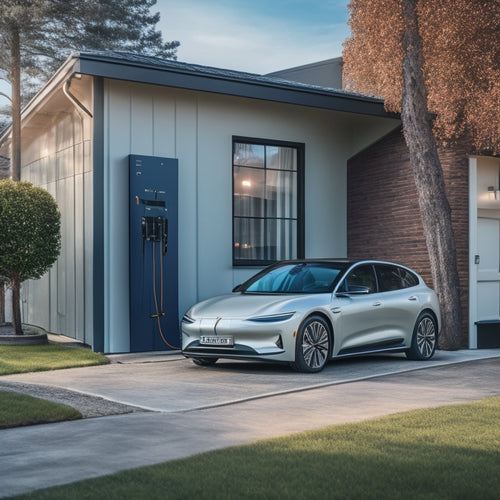
A Step-by-Step Guide to Rooftop Solar Installation Cost
Share
You're about to invest in a rooftop solar installation, and understanding the costs involved is vital to making an informed decision. You'll need to evaluate the upfront costs, which can be significant, as well as financing options and long-term savings. Your roof's size, condition, and orientation will also impact the installation's feasibility and energy production. Choosing the right equipment, such as high-efficiency solar panels, and understanding installation labor and permit fees are also important. Additionally, you'll want to investigate incentives and tax credits, as well as ongoing maintenance expenses. As you break down these components, you'll get a clearer view of the total cost and how it translates to long-term value.
Key Takeaways
- Assess your roof's size, condition, and orientation to determine its suitability for solar installation and potential energy production.
- Choose high-efficiency solar panels (>20% efficiency) and a system configuration that matches your energy needs and budget.
- Professional installation labor costs range from $2,000 to $5,000, including permit fees, which vary by location ($500 to $2,000).
- Federal and state incentives, such as the Solar Investment Tax Credit (ITC), can significantly reduce installation costs, and local rebates may also apply.
- Regular maintenance is crucial for optimal performance and longevity, with costs including monitoring, cleaning, inverter upkeep, and performance assessments.
Understanding Solar Panel Costs
Your investment in rooftop solar installation begins with understanding the costs associated with solar panels. The upfront cost of solar panels can be significant, but it's important to take into account the long-term solar savings and return on investment.
With financing options available, you can spread the cost over time, making energy independence more accessible.
The environmental impact of switching to solar energy is substantial, and the installation timeline is typically around 1-3 days, depending on the complexity of the project.
Once connected to the grid, you'll start generating clean energy and reducing your reliance on traditional power sources.
To maximize your solar savings, it's vital to maintain your system properly. Regular cleaning and inspections will guarantee peak performance.
Assessing Roof Size and Condition
A suitable rooftop is a critical factor in determining the feasibility of a solar installation project. You'll need to evaluate your roof's size and condition to ascertain it can support the solar panels and generate the desired amount of power.
Start by examining your roof's orientation, as a south-facing roof receives the most sunlight and is ideal for solar panels. Next, conduct a shading analysis to identify any obstructions that might reduce energy production.
Inspect your roof's structural integrity to confirm it can handle the weight of the solar panels and withstand environmental elements. Check local regulations to determine if there are any restrictions on rooftop solar installations in your area.
Additionally, consider the installation accessibility, as a more complex installation may increase costs. Finally, examine your roof materials, such as asphalt shingles or metal roofing, to verify they're compatible with the solar panels.
Choosing the Right Equipment
When choosing the right equipment for your rooftop solar installation, you'll need to take into account the quality of the solar panels, as high-efficiency panels can maximize your energy production.
You'll also need to decide on the system configuration that best suits your needs, including the number of panels, inverters, and mounting options.
Solar Panel Quality
High-efficiency solar panels, like precision-crafted machines, convert sunlight into electricity with extraordinary accuracy, making them an essential component of a rooftop solar installation.
You'll want to select panels with high solar efficiency, typically above 20%, to maximize energy production. This is especially important if you have limited roof space or want to power a large load.
Look for panels with a high power output per unit area, measured in watts per square foot (W/sqft). A higher power output means you'll need fewer panels to achieve your desired energy output, reducing installation costs.
Additionally, consider panel longevity, as high-quality panels can last up to 30 years or more. This is critical, as you'll want your system to generate power for decades to come.
Be certain to research the manufacturer's warranty and performance guarantees to guarantee you're getting a reliable product.
System Configuration Options
With your rooftop solar installation, you'll need to select the right equipment to optimize energy production and minimize costs. This involves choosing the right system configuration, which can be a complex process.
You'll need to take into account factors such as your energy needs, budget, and roof size to determine the best system type for your installation.
There are several system types to choose from, including grid-tied, off-grid, and hybrid systems. Grid-tied systems are the most common and cost-effective option, as they allow you to sell excess energy back to the grid.
Off-grid systems are ideal for remote locations with no access to the grid, while hybrid systems combine grid-tied and off-grid capabilities.
When selecting your system, prioritize energy efficiency by opting for high-efficiency solar panels and inverters. Additionally, evaluate the warranty and durability of the equipment to guarantee long-term performance and minimize maintenance costs.
Installation Labor and Permit Fees
Installing rooftop solar panels requires a considerable amount of labor, which greatly adds to the overall cost of the project.
You'll need to factor in the cost of hiring a professional installation team, which can range from $2,000 to $5,000 or more, depending on the complexity of the installation process and the size of your system.
The installation process typically involves several stages, including evaluating your roof's condition, designing the system, and installing the panels and inverters.
Each stage requires specialized labor and equipment, which adds to the overall cost. Additionally, you'll need to obtain necessary permits and approvals from local authorities, which can add hundreds or even thousands of dollars to the total cost.
Permit requirements vary by jurisdiction, but typically include electrical and building permits, as well as inspections to verify compliance with local codes and regulations.
You'll need to factor in the cost of these permit requirements, which can range from $500 to $2,000 or more, depending on your location and the complexity of the project.
Incentives and Tax Credits
While the upfront costs of a rooftop solar installation can be intimidating, you're eligible for various incentives and tax credits that can greatly reduce your expenses.
Federal incentives, such as the Solar Investment Tax Credit (ITC), allow you to claim a percentage of your installation costs as a tax credit. Additionally, many states offer credits or rebates for solar installations, which can additionally reduce your expenses.
Local governments and utilities may also provide rebates or financing options to encourage solar adoption. Moreover, you can benefit from energy savings over time, which can offset the initial investment.
It's crucial to examine the tax implications of these incentives and how they'll affect your overall costs. You may also be eligible for installation grants or solar loans with favorable terms.
Ongoing Maintenance Expenses
Your rooftop solar installation requires regular maintenance to guarantee peak performance and longevity. Neglecting maintenance can lead to reduced energy output, safety hazards, and even system failure. To avoid these issues, it's crucial to budget for ongoing maintenance expenses.
Some important maintenance tasks include:
-
Monitoring systems: Regularly review your system's performance data to identify potential issues and optimize energy production.
-
Cleaning services: Schedule regular cleaning to remove dirt and debris that can reduce energy output.
-
Inverter upkeep: Perform routine checks and replacements to make certain your inverter operates efficiently and effectively.
In addition to these tasks, consider the following expenses:
Your maintenance schedule should include performance assessments, safety inspections, and troubleshooting tips to make certain your system operates at its best.
Be sure to review your warranty coverage to understand what's included and what's not. By budgeting for these ongoing expenses, you can enjoy a safe, efficient, and reliable rooftop solar installation.
Frequently Asked Questions
Can I Install Solar Panels on a Metal or Tile Roof?
You can install solar panels on a metal or tile roof, but you'll need to take into account metal roof considerations, such as ensuring compatibility with your roof's material and structure, while tile roof advantages include ease of installation and added durability.
Will Solar Panels Affect My Roof's Warranty or Insurance?
You're going green, but might void your roof warranty - nice trade-off, right? Fortunately, most manufacturers won't penalize you; however, you'll need to review your roof warranty implications and guarantee adequate solar insurance coverage to avoid any costly surprises.
Can I Add Solar Panels to an Existing Solar Array?
You can expand your existing solar array by adding compatible solar panels, ensuring seamless integration with your current system. Consult with a professional to determine the best upgrade options, ensuring a harmonious blend of old and new technology.
Do Solar Panels Work During a Power Outage?
You're wondering if solar panels work during a power outage? Unfortunately, they don't provide backup power during outages unless you have a battery storage system, which allows you to access stored energy when the grid goes down.
Can I Move Solar Panels to a New Home if I Relocate?
You're wondering if you can take your eco-friendly investment with you when relocating - the good news is that, yes, you can undertake solar panel relocation, but it'll require a professional assessment to guarantee a smooth, cost-effective moving solar panels process.
Related Posts
-

5 Essential Tips for Buying EV Charging Systems Online
When purchasing an EV charging system online, you'll want to make sure you're making an informed decision. First, det...
-

Why Cities Need Smart Charging Infrastructure Now
You're about to experience a tidal wave of electric vehicles hitting your city's streets, and it's essential you're p...
-

Planning for an Electric Vehicle-Friendly Urban Future
As you plan for an electric vehicle-friendly urban future, you'll need to integrate high-power charging stations, sma...


